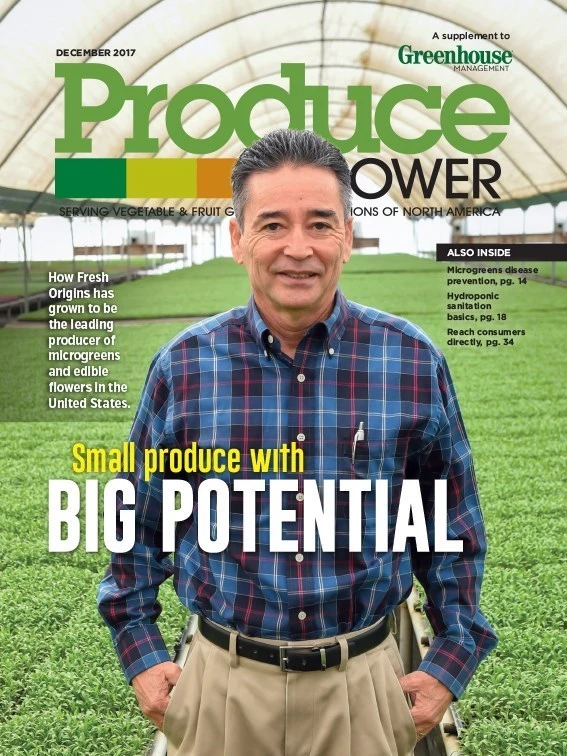

When the Kerns, owners of Nova, Ohio-based Bradwood Farm, began growing and selling greenhouse produce in 2015, they focused on lettuce and tomatoes. Since then, they have expanded their offerings to many more crops, including the nontraditional greenhouse offerings of fennel, beets and strawberries.
At the family farm, Katy Kern grows the produce, and her husband, Douglas Kern, performs maintenance. They work in a 5,000-square-foot, two-bay greenhouse and use both NFT and bato bucket hydroponic systems. Both the structure and the hydroponic systems are provided by CropKing.
While turning heads with their more traditional crops (Bradwood Farms recently won a “top tomato” award at a farmers market in Ohio), the Kerns are producing those less common crops, such as the Chinese cabbage bok choy and nasturtium.
“[Nasturtium] is an edible flower,” Katy explains. “You eat the whole flower. It’s sweet at first, and then it has a radish kick at the end — a little bite at the end.” She adds, “I also sell a ton of watercress.” An aquatic plant, the aptly-named watercress also goes by the botanical name Nasturtium officinale. Nasturtium (from the genus Tropaeolum) and watercress are in the same order, but not in the same family.

A fitting background
Although the greenhouse business is relatively new to the Kerns, they have farmed at Bradwood Farm since 1999. “I had a huge herd of sheep years ago,” Katy says. In the past two decades, the Kerns have raised beef cattle, chickens and hogs, and produced hay on their 130 acres. They have also produced maple syrup, tapping maple trees from the sizable forest on their property.
Katy and Douglas come from a construction background, having ran a company in that industry for 23 years. For a year and a half, they performed double duty, running the construction business while setting up the greenhouse operation. Their construction background suited them well in building their greenhouse. Other than pouring some concrete, Katy and Douglas built the structure themselves.
Since the Kerns’ greenhouse became fully operational, Douglas has continued to use his technical skills to advance the business. “He’s done some interesting things because we have oil and gas wells here on the property, but it likes to go down,” Katy says. “He put in a wood burner, and he did these heat exchangers to integrate with the CropKing system so I can have backup heat for my greenhouse. He also did a heat exchanger technique for my water, so in the wintertime when I change my nutrient tank, it can heat up my water before it goes in the nutrient tank. He’s always coming up with neat ideas on how to improve.”
Growing methods
In CropKing’s nutrient film technique (NFT) channels, Katy grows crops such as lettuce (varieties include Bibb, oakleaf, Salanova and romaine), leafy greens, basil, herbs, strawberries, beets and fennel. In the company’s bato bucket systems, she grows tomatoes, cucumbers, hot peppers and green beans.
The two systems, as well as different crops within a single system, require separate nutrient mixes. “The tomatoes call for a totally different nutrient mix than my NFT channels, and then the beans and the peppers have a separate nutrient tank also,” Katy says. “I have three different nutrient tanks here in the greenhouse.”
The NFT system is Katy’s major system and is set up to a 1,200-gallon nutrient tank. Meanwhile, she uses a 100-gallon tank for her tomatoes, and a separate 100-gallon tank for her cucumbers, beans and peppers.
Katy regularly rotates her crops throughout the year. “[This winter], I’m doing spinach, which I can only do in the wintertime because it gets too hot in here in the summer and it bolts,” she says. “I primarily do green beans in the wintertime also because it’s harder to get them. And tomatoes — I start those in January, and then I end up pulling them in November.” She grows cucumbers, basil and lettuce year-round.

Catering to customers
Bradwood Farm sells to some grocery stores near her in Ashland County, as well as stores in Northwest Ohio. She also sells her product at farmers markets in Northeast Ohio and works with a community supported agriculture (CSA) program in Central Ohio.
Throughout the year, customer demands change. “It does slow down in the wintertime, because, to me, people like to eat comfort food more than salads,” Katy says. However, a base of her customers emails her with specific orders and she delivers their orders to a drop-off location. “There is that group of people that like to eat fresh salads all year-round,” she says.
Katy produces herbs for customers in the winter because they cook more at that time of year. “I do rosemary and thyme, and I also do cilantro in the wintertime,” she says. She also grows parsley year-round because she is in a good market for the crop.
“I just started with lettuce and tomatoes,” she says. “[But] I really expanded into a lot of Asian greens like Tatsoi, Carlton, Tokyo [Bekana] — just a bunch of different ones. They have different flavors and different colors — lighter greens, darker greens.”
WANT MORE?
Enter your email to receive our newsletters.

Explore the December 2017 Issue
Check out more from this issue and find your next story to read.
Latest from Produce Grower
- The Growth Industry Episode 3: Across the Pond with Neville Stein
- PG CEA HERB Part 2: Analyzing basil nutrient disorders
- University of Evansville launches 'We Grow Aces!' to tackle food insecurity with anu, eko Solutions
- LettUs Grow, KG Systems partner on Advanced Aeroponics technology
- Find out what's in FMI's Power of Produce 2025 report
- The Growth Industry Episode 2: Emily Showalter on how Willoway Nurseries transformed its business
- 80 Acres Farms expands to Georgia, Texas and Colorado
- How BrightFarms quadrupled capacity in six months





